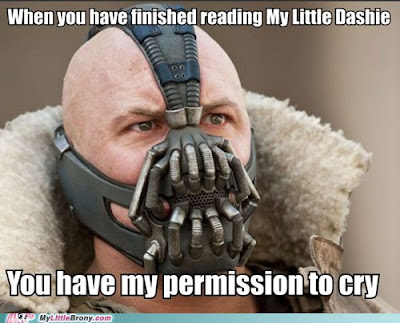My Little Pony: Friendship is Magic has become something of a phenomenon. A story intended for little girls now fascinates all age groups and genders. Unicorn prodigy Twilight Sparkle doesn’t understand the value of making friends, so her teacher, Princess Celestia, instructs her to travel to Ponyville. Here she meets the spastic and arguably schizophrenic Pinkie Pie; the mumbling pegasus Fluttershy; the fabulous fashionista unicorn Rarity; the farm-girl apple bucker Applejack; and the tomboy pegasus Rainbow Dash.
Since last spring, a fan-written story concerning rainbow dash that has become absurdly popular. Almost all members of the culture know of My Little Dashie by RobCakeran53 on Deviantart. In fact, the My Little Brony faction of Memebase has produced several My Little Dashie memes.
In the story, a young man struggles through a depressingly empty life in a washed-up city, until the day he discovers an infant pegasus in a cardboard box in the street: Rainbow Dash, straight out of the TV show.
Our hero is so wimpy he’s almost laughable, the plot is holey, and the writing is simplistic and grammatically unsavory. However, it's this simplicity that makes it work. The writing has the feel of a young man pouring his heart out. It is simple, honest, intimate.
Yet questions remain, and many fans are skeptical. After all, the story's Rainbow Dash does not have the pushy spunk of the flawed TV show character.
Why is this fanfiction piece so popular? I’m not claiming to know the cultural reasons behind it, but I’d like to unpack some of the storytelling.
4. Despite the honest tone, some lines are brilliantly manipulative.
"'Oh...' The realization strikes that she has no clue what is going on, where she is, who I am, or anything else. She's beyond the word 'lost': she is misplaced."
"I know the meme gets old, but I must say it: my heart exploded again."
3. It makes the best of tantalizing bits of fandom. The author surprises us with the bright spots of color that wade in from the pony world, and I think maintaining this surprise - even though it’s a fanfiction - is part of its delight. These are the moments when I found myself smiling. (He says of one character, “Better yet, the rumors on the internet were true; her mane did smell like cotton candy.”)
2. Also for fans - this story emphasizes two elements the show rarely utilizes: the girls' relationships with male figures, and their relationships with their parents. This is refreshing for fans. If Rainbow Dash had a strong relationship with a father figure, this would make so much sense. She's the most boyish of them all. This story maximizes that thematic gap.
1. The fifteen-year span. The writer avoids lulls by picking out only certain memoir-like episodes from the many years. If it weren't for this long time period and the father-daughter relationship that develops because of it, this story would not have its impact. It would not overcome the almost-creepy fascination the character has for the pony.
What do you think? Is there even more to this minor Internet phenomenon?






